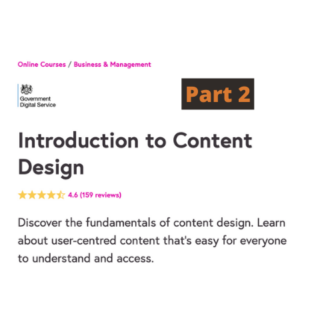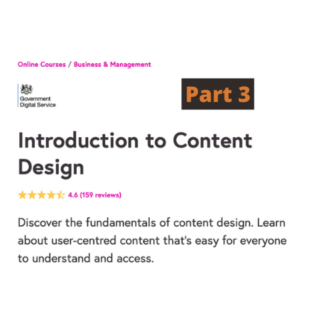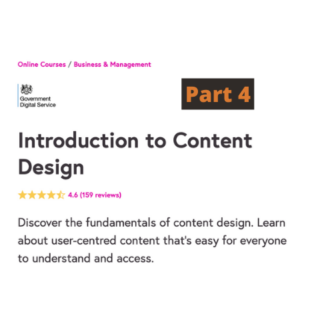Our content specialist, Ben, enrolled on the Government-led course about Content Design. He learnt what a content designer does and how their work affects a user.
Last week, our content specialist, Ben, embarked on his journey to understand more about content design and how it can be used to create more inclusive and user-focused digital services.
He enrolled on the Introduction to Content Design course being delivered by the Government Digital Service (GDS) on the FutureLearn course platform. This blog outlines what he learned in his first week…
My perception of content design
The first question that was posed to me at the beginning of the course was ‘What is content design?’ Having seen the work of content designers and already being in the digital inclusivity industry, I figured I had a head start with this question.
My answer was “Content design is about tailoring your content to meet the needs of the user”.
I wasn’t wrong but realised very quickly that I only knew the broad elements of content design and what it entails. It is in fact much more detailed than simply delivering content to meet the needs of the user. So, what is content design?
What content design is
Thanks to the course, I understand content design as a definition much better, but rather than try to explain it myself, I found that the course tutors offered the best definitions.
In the words of Jane Wilkinson, the Senior Content Designer at the Department of Work and Pensions, as well as the course tutor, “Content design is a combination of writing and analytical skills. It’s about using data and evidence to meet user needs.”
Marian Foley, the Senior Content Designer at GDS commented: “content design to me means translating complex policy language into simple language that users can understand.” She went on to say “It’s understanding the context, it’s making sure it’s accessible and inclusive, and it’s making sure that you’re putting it in the best place for users to find it.”
Perhaps the best quote was that from Nigel Jones, the Senior Content Designer at the Ministry of Justice: “Content design is a way of thinking. It’s about using data and evidence to give people the content they need in the format they need at the right place and at the right time.”
What areas does content design cover?
As a content creator myself, I understand that content doesn’t just cover the words within content (the copy). Content is not that simple. It is everything you see, hear and watch online. For example:
- A title of a page
- Headings
- Image captions
- Email subject line
- Meta-descriptions
- GIFs
- Videos
- Podcasts
- Links (and where they point to)
- Spelling
- Grammar
- Lists
- Much more!
This is no different for a content designer. A common misconception is that content designers deal with just copy, but this is false. As taught in the course, a content designer also deals with the above, and all of the strategic elements around delivering content, such as:
- What content to create
- Who that content is aimed at
- Deciding what subjects to include on a web page
- How pages relate to other content pages
- How pages link together
The job of a content designer is not just about designing a specific page of content but dealing with the entire user journey.
What do content designers do, and what knowledge do they need?
What do content designers do, and who do they work alongside?
I went into the course with an expectation that content designers, much like me as a content creator, deal with all types of content. This is correct. But, it goes much broader than that.
The course emphasised the fact that content designers focus on the end-to-end journeys. What I didn’t think about was how the role of a content designer fits into a multi-disciplinary team.
Content design is about focusing on the whole user journey. This means working with disciplines such as:
- Project managers
- User researchers
- Service designers
- Interaction designers
- Delivery managers
The course touched on what some of those roles do too!
What skills a content designer needs
This was a really useful part of the course. It allowed me to compare my own skills against those that are useful for a content designer. The main skills are:
- Understanding the topic – a good understanding of a topic is essential to be able to design content around it
- Ability to maintain good relationships with colleagues – Working in a multi-disciplinary team means working with other colleagues, the ability to communicate is essential.
- Ability to work quickly and with unknowns – The job as a content designer is really to try and work out what a journey is and what the steps are to get to that point.
This module of the course gave me a great understanding of skills I need to hone to become a more effective content creator and, ultimately, a content designer.
Designing for the user
The main goal for a content designer is understanding what a user wants and how they expect to be given that information.
It’s not just about online content
The key thing I learned in this module is that, whilst online content is important, that’s not where the job of a content designer ends.
Some users expect a letter to be sent to them, instead of online communication. Letters, pamphlets and leaflets are all the responsibility of a content designer. They need to be concise and clear and reflect the online content.
At HeX it’s very rare that we produce offline content, however, when we do, I know now that this also needs to be given the same level of attention as online content. It seems simple, but I’m guilty for not giving offline content the same attention as I do to online content!
Defining users
One thing that we’ve recently started to implement at HeX is user personas. These personas come in useful when determining who we’re creating digital services for, and who we’re aiming our communication at.
The content design course took this one step further, giving some great tips on how to define users and the best way to understand their needs.
The method the course touched on was explaining who a user was, what they want and why they need to do it. This is a user story. The template for creating a user story is to format it like the following:
As a… [describe the user]
I need to… [say what the user needs to do]
So that I… [say why the user needs to do it]
From this information, the course tasked us with creating our own user story based on fictional characters. For example:
As a little pig
I need to have a solidly built house
So that the wolf doesn’t blow it down
From there the course touched on the acceptance criteria of a user story. Simply, how can we as content designers understand when this user has their needs met properly.
Understanding user story acceptance criteria
The example for this element of the course was the following user story:
As a dinner host
I need to set the table
So that I can serve dinner to my guests.
The acceptance criteria for this is when those user needs are met. For this example the acceptance criteria is:
- It’s done when there are plates on the table
- It’s done when there is cutlery on the table
- It’s done when there are glasses on the table.
The acceptance criteria is something that proved incredibly valuable for me. We’re often so caught up with what our users need, we never stop to think about when that need is met. As a content creator, I’m adept at understanding what my users need from our content. However, there are few instances where I will evaluate the content that has been produced.
The course has taught me to ask the following questions…
- Has the user had their needs met?
- How have we met the user needs?
- How can we identify that we’ve met their needs?
Simple evaluative questioning will allow me to come back to content and gather a greater understanding
of whether the user has all of the information they require.
My thoughts on Week 1 of the course
The course has been extremely valuable so far. This is only week one of four and I have high expectations of what’s to come.
I think the biggest takeaway from this is that there’s always more that can be done. As a content creator, it’s easy to get into the habit of becoming a content mill; churning out content for the sake of creating content.
The course has allowed me to take a step back from creating the content itself, and focus on the user and whether their needs are being met properly.
It has also taught me the benefit of evaluation, being able to produce content and understand whether it has solved a user need is incredibly important. This is certainly something I wasn’t doing before. Whilst we have the personas and the user stories, the key aspect I’m missing as a content creator is the evaluative data. What’s the point in producing something if I don’t ensure the user needs have been met after creating it?!



